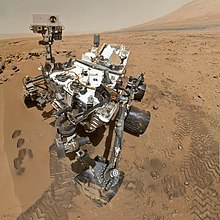
Back Ruimteverkenning Afrikaans استكشاف الفضاء Arabic Esploración espacial AST Kosmosun tədqiqi Azerbaijani اوزای آراشدیرمالاری AZB Даследаванне космасу Byelorussian Изследване на Космоса Bulgarian মহাকাশ অনুসন্ধান Bengali/Bangla Istraživanje svemira BS Exploració espacial Catalan


| Part of a series on |
| Spaceflight |
|---|
 |
|
|
Space exploration is the use of astronomy and space technology to explore outer space.[1] While the exploration of space is currently carried out mainly by astronomers with telescopes, its physical exploration is conducted both by uncrewed robotic space probes and human spaceflight. Space exploration, like its classical form astronomy, is one of the main sources for space science.
While the observation of objects in space, known as astronomy, predates reliable recorded history, it was the development of large and relatively efficient rockets during the mid-twentieth century that allowed physical space exploration to become a reality. Common rationales for exploring space include advancing scientific research, national prestige, uniting different nations, ensuring the future survival of humanity, and developing military and strategic advantages against other countries.[2]
The early era of space exploration was driven by a "Space Race" between the Soviet Union and the United States. A driving force of the start of space exploration was during the Cold War. After the ability to create nuclear weapons, the narrative of defense/offense left land and the power to control the air the focus. Both the Soviet Union and the U.S. were racing to prove their superiority in technology through exploring space. In fact, the reason NASA was created was as a response to Sputnik I.[3]
The launch of the first human-made object to orbit Earth, the Soviet Union's Sputnik 1, on 4 October 1957, and the first Moon landing by the American Apollo 11 mission on 20 July 1969 are often taken as landmarks for this initial period. The Soviet space program achieved many of the first milestones, including the first living being in orbit in 1957, the first human spaceflight (Yuri Gagarin aboard Vostok 1) in 1961, the first spacewalk (by Alexei Leonov) on 18 March 1965, the first automatic landing on another celestial body in 1966, and the launch of the first space station (Salyut 1) in 1971. After the first 20 years of exploration, focus shifted from one-off flights to renewable hardware, such as the Space Shuttle program, and from competition to cooperation as with the International Space Station (ISS).
With the substantial completion of the ISS[4] following STS-133 in March 2011, plans for space exploration by the U.S. remained in flux. The Constellation program aiming for a return to the Moon by 2020[5] was judged unrealistic by an expert review panel reporting in 2009.[6] Constellation ultimately was replaced with the Artemis Program, of which the first mission occurred in 2022, with a planned crewed landing to occur with Artemis III.[7] The rise of the private space industry also began in earnest in the 2010s with the development of private launch vehicles, space capsules and satellite manufacturing.
In the 2000s, China initiated a successful crewed spaceflight program while India launched the Chandrayaan programme, while the European Union and Japan have also planned future crewed space missions. The two primary global programs gaining traction in the 2020s are the Chinese-led International Lunar Research Station and the US-led Artemis Program, with its plan to build the Lunar Gateway and the Artemis Base Camp, each having its own set of international partners.
- ^ "How Space is Explored". NASA. Archived from the original on 2 July 2009.
- ^ Roston, Michael (28 August 2015). "NASA's Next Horizon in Space". The New York Times. Retrieved 28 August 2015.
- ^ "NASA Created". HISTORY. Retrieved 27 April 2023.
- ^ Chow, Denise (9 March 2011). "After 13 Years, International Space Station Has All Its NASA Rooms". Space.com.
- ^ Connolly, John F. (October 2006). "Constellation Program Overview" (PDF). Constellation Program Office. Archived from the original (PDF) on 10 July 2007. Retrieved 6 July 2009.
- ^ Lawler, Andrew (22 October 2009). "No to NASA: Augustine Commission Wants to More Boldly Go". Science. Archived from the original on 13 May 2013.
- ^ ""What We Need Now is Urgency": Looking Back at Artemis After 5 Years". www.americaspace.com. 26 March 2024. Retrieved 9 May 2024.